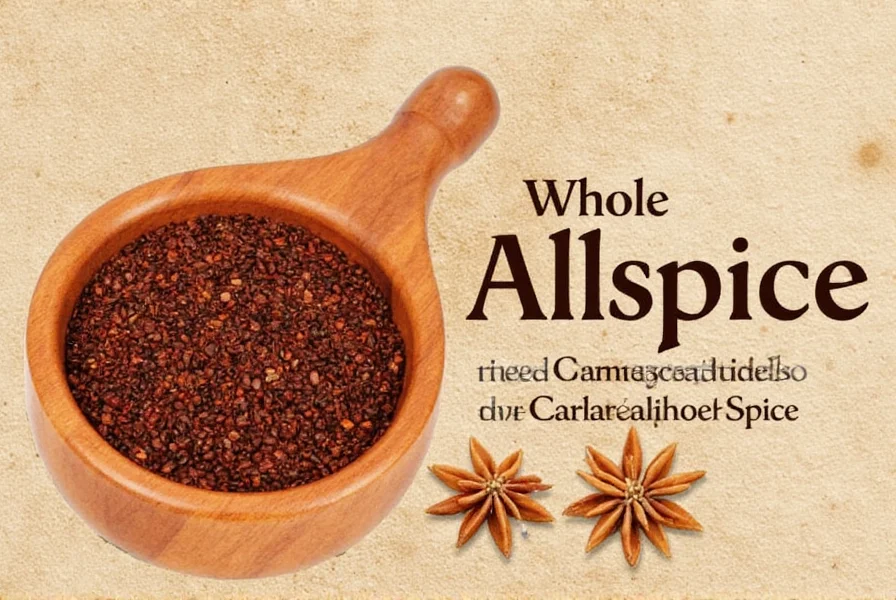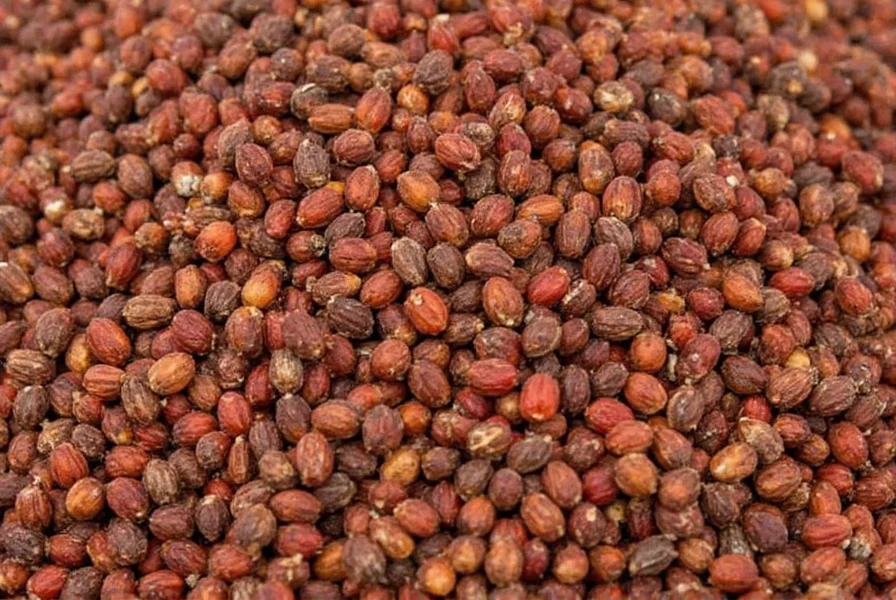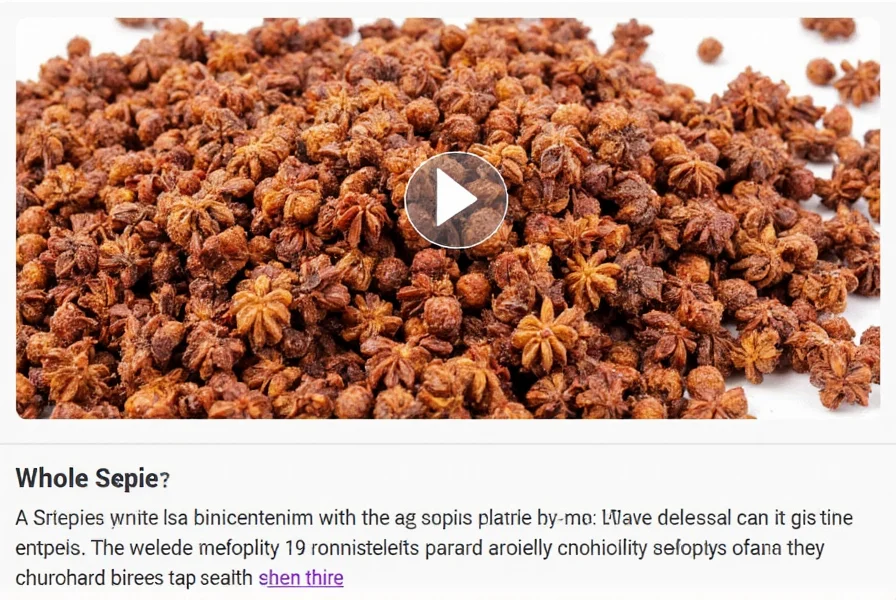Native to the Greater Antilles, southern Mexico, and Central America, allspice earned its name because early European explorers thought its flavor resembled a blend of multiple spices. The scientific name Pimenta dioica reflects its peppercorn-like appearance, though it's botanically unrelated to black pepper.
Whole Allspice vs. Ground Allspice: Key Differences
| Characteristic | Whole Allspice Berries | Ground Allspice |
|---|---|---|
| Shelf Life | 18-24 months in airtight container | 6-12 months before significant flavor loss |
| Flavor Intensity | Full, complex profile when freshly ground | Muted, one-dimensional after prolonged storage |
| Culinary Applications | Stews, pickling, mulled beverages, stocks | Baking, rubs, quick sauces |
| Preparation Required | Must be crushed or ground before use | Ready to use immediately |
Maximizing Flavor in Your Cooking
For optimal results with whole allspice berries, follow these professional techniques:
- Dry toast before grinding: Heat berries in a skillet over medium-low heat for 2-3 minutes until fragrant, enhancing their essential oils
- Grind fresh for each use: Use a dedicated spice grinder or mortar and pestle for maximum flavor release
- Infuse in liquids: Add whole berries to stocks, braises, or mulled wine, removing before serving (typically 1 berry per cup of liquid)
- Create custom blends: Combine with whole cloves, cinnamon sticks, and star anise for authentic jerk seasoning or pickling spice
Proper Storage Methods
Preserve your whole allspice berries' potency with these storage recommendations:
- Transfer from original packaging to an airtight glass or metal container
- Store in a cool, dark cupboard away from heat sources and sunlight
- Maintain consistent temperature (fluctuations accelerate flavor loss)
- Consider freezing for long-term storage (up to 3 years) in vacuum-sealed bags
Test freshness by crushing a berry between your fingers - potent allspice should release a strong, complex aroma immediately. Stale berries produce little scent and yield flat-tasting ground spice.
Substitution Guidance for Whole Allspice
When whole allspice isn't available, these alternatives work in specific applications:
- For pickling or stocks: Use 1 whole clove + 1 small cinnamon stick per allspice berry called for
- For baking: Substitute ⅛ teaspoon ground allspice per berry (reduce liquid by ½ teaspoon)
- For Caribbean dishes: Combine equal parts ground nutmeg, cinnamon, and cloves (¼ tsp total per berry)
Note that substitutions never perfectly replicate allspice's unique flavor profile, which contains over 50 aromatic compounds. Serious cooks maintaining authentic recipes should seek genuine whole allspice berries.
Traditional Culinary Applications
Chefs worldwide rely on whole allspice for these signature preparations:
- Jamaican jerk marinades: Combined with scotch bonnet peppers and thyme in traditional pimento wood smoking
- Swedish meatballs: Simmered in broth for authentic flavor before being removed prior to serving
- Middle Eastern stews: Added to lamb tagines and kibbeh preparations for warm complexity
- Caribbean pickles: Essential in Trinidadian chow and Jamaican pepper sauce recipes
- German mulled wine: Steeped with orange peel and cinnamon in traditional Glühwein

Where to Source Quality Whole Allspice
For the freshest whole allspice berries, consider these purchasing strategies:
- Seek recent harvest dates (within 6 months) from specialty spice retailers
- Choose plump, dark brown berries without cracks or holes
- Verify single-origin sourcing (Jamaican allspice typically offers the most complex flavor)
- Avoid pre-ground "allspice blends" which often contain fillers
- Consider purchasing from Caribbean importers for maximum freshness
Reputable spice companies typically provide harvest dates and origin information. When properly sourced, whole allspice berries should have a pronounced aroma even through sealed packaging.

Frequently Asked Questions
Can I substitute ground allspice for whole allspice in recipes?
Yes, but with adjustments. Use ⅛ teaspoon ground allspice per whole berry called for in the recipe, and add it later in the cooking process since ground spice loses potency faster. For dishes requiring long simmering like stews, whole berries provide superior flavor development.
How many whole allspice berries equal one teaspoon of ground allspice?
Approximately 12-15 whole allspice berries yield one level teaspoon of freshly ground spice. The exact count varies based on berry size and grinding method. For precise measurements in baking, weigh berries (5 grams of whole berries equals about 1 teaspoon ground).
Why do some recipes specify whole allspice instead of ground?
Recipes call for whole allspice when gradual flavor infusion is needed during extended cooking times. Whole berries release flavors slowly in stocks, braises, and pickling solutions, creating more complex flavor profiles than ground spice which can become bitter when simmered too long.
Can I grow my own allspice berries?
Allspice trees (Pimenta dioica) require tropical conditions (USDA zones 10-11) with high humidity and cannot tolerate frost. They take 7-10 years to produce berries. Most home gardeners outside the Caribbean find it impractical to grow allspice, making purchasing from specialty retailers the most viable option.
How can I tell if my whole allspice berries have gone bad?
Fresh allspice berries should be dark brown, plump, and emit a strong, complex aroma when crushed. Signs of deterioration include faded color, shriveled appearance, lack of fragrance, or musty smell. Properly stored in an airtight container away from light, whole allspice maintains quality for 18-24 months.











 浙公网安备
33010002000092号
浙公网安备
33010002000092号 浙B2-20120091-4
浙B2-20120091-4